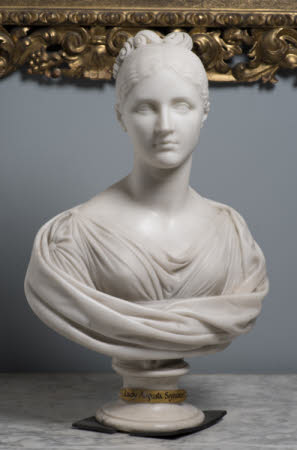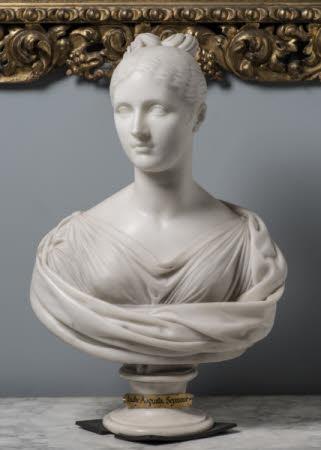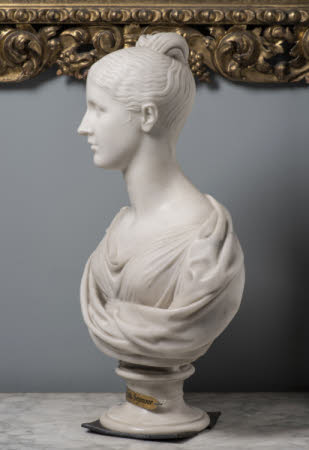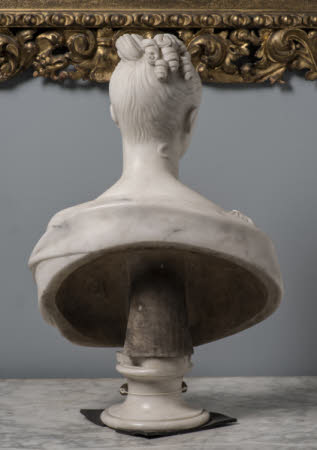Portrait bust of Lady Augusta Hervey (1798-1880), later Lady Augusta Seymour
Lorenzo Bartolini (Vernio, Tuscany 1777 – Florence 1850)
Category
Art / Sculpture
Date
1818 - 1819
Materials
Marble
Measurements
1300 x 510 mm
Place of origin
Florence
Order this imageCollection
Ickworth, Suffolk
NT 852223
Summary
Sculpture, marble; Portrait bust of Lady Augusta Hervey, later Lady Augusta Seymour (1798-1880); Lorenzo Bartolini (1777-1850); Florence, c. 1818-19. One of a group of portraits of members of the Hervey family commissioned from the sculptor Lorenzo Bartolini during a sojourn in Florence in 1818 or 1819. During the years of peace in Europe following the battle of Waterloo and the final defeat of Napoleon, the British travelled to the Continent in large numbers. Most of the grander visitors to Florence at this time would commission work from Bartolini, who was renowned for his sensitivity as a portrait sculptor, as well as his competitive prices. Also at Ickworth is a full-size bust by Bartolini of Augusta Hervey’s mother Elizabeth Albana Upton, and a smaller version of this portrait of Augusta
Full description
A portrait bust in marble depicting Lady Augusta Elizabeth Wilhelmina Hervey, by Lorenzo Bartolini. The sitter is shown with her head turned slightly to her right, her hair parted at the centre and drawn back over her head, tied at the top of the head into a large single tail and with a series of ringlets. She wears a dress reflecting the Greek garment known as a chiton, fastened with button-like clasps at each shoulder, whilst around the lower part of the bust a shawl twists and wraps around the sitter’s body. Mounted on a waisted marble socle. This is one of a group of portrait busts of members of the Hervey family commissioned by Frederick William Hervey, 5th Earl and 1st Marquess of Bristol (1769-1859), during a stay in Florence in 1818-19 and from the sculptor Lorenzo Bartolini. Six busts are currently known, of three sitters: Lord Bristol, now at Felbrigg (NT 1401967); his wife Elizabeth Albana Upton, Marchioness of Bristol (1775-1844) in three busts, one sold at auction in 1987, another at Bignor Park and the third at Ickworth (NT 852210); two busts of Lady Augusta Hervey, both at Ickworth, the present full-size portrait and a small-scale version (NT 852215), also made in Bartolini's studio. Lady Augusta Hervey was the eldest of the nine children of Frederick William Hervey, later 5th Earl and 1st Marquess of Bristol (1769-1859) and his wife Elizabeth Albana Upton, Marchioness of Bristol (1775-1844). Her younger brother Frederick William (1800-1864) would become 2nd Marquess of Bristol on his father’s death. After the Hervey family had in 1821 returned from its four-year long Continental sojourn, Lady Augusta appears from time to time in newspaper reports of balls and other social events, often in the company of her parents and her sister Lady Georgina (for example, Bury and Norwich Post, 16 October 1822). She must though have resigned herself to spinsterhood when in 1832, at the age of 34, she married Frederick Charles William Seymour (1797-1856), henceforth being styled Lady Augusta Seymour. The couple had six children and lived in Brighton from 1832 to 1847, at the Hervey house in Sussex Square. The Hervey family’s European tour began in the summer of 1817, with a journey though France to Italy, from where the family returned to northern Europe in 1819. They spent the whole of 1820 in Paris, only returning to Ickworth in May 1821. The first months of the tour are documented by Augusta Hervey in a journal that she kept, unfortunately it seems, only up to the end of 1817 (London, British Library, Add. Ms. 62922). The journal recounts the family’s setting out from London on 10 July 1817 as a party of 26 people – including the parents, all nine children and no fewer than twelve servants. The Herveys arrived in Florence for their first stay in the city in November 1817, but remained for just a few weeks, before moving on to Rome. There is no mention at this time of a visit to Lorenzo Bartolini’s studio. It must therefore be assumed that the 5th Earl commissioned the group of portrait busts from Bartolini during a second period in Florence, which must have been in 1818 or 1819. The Herveys were among many British visitors to Florence in the years after Waterloo, who found their way to the studio of Lorenzo Bartolini. Regarded in his lifetime as one of the very greatest European sculptors, Bartolini was trained in the neo-classical tradition that reached a height of popularity in the first decades of the nineteenth century. Born to a poor family, he grew up and undertook early training as a sculptor in Florence, before moving to Volterra, to study with the French sculptor in alabaster, Barthélemy Corneille (c. 1760–1812). Whilst working for Corneille, Bartolini came across drawings by the British neo-classical sculptor John Flaxman (1755-1826), which made an enormous impact on him. A supporter of the revolutionary movements sweeping through Europe at this time, Bartolini served in the French army before moving to Paris, where he worked in the studio of the painter Jacques-Louis David. He also at this time struck up a close friendship with another up-and-coming painter, Jean-Auguste-Dominique Ingres (1780-1867). Bartolini had always been closely interested in Italian art of the earlier periods and, as his career developed, his style evolved towards a manner that reflected the contemporary revival of interest in the art of the Renaissance. Bartolini became one of the favoured artists of the Emperor Napoleon I and his entourage, even following the defeated emperor into exile on the island of Elba in 1814. After Napoleon’s final defeat at Waterloo, Lorenzo Bartolini established his studio in Florence, but his reputation as a diehard Bonapartist meant that for a long time he was denied access to larger public commissions. Instead he was obliged to make his living largely through privately commissioned sculpted portraits, soon becoming the most fashionable portrait sculptor in Florence. Thus he made portraits of many of the foreign visitors, a good number of them British and Irish, who flocked to Florence after peace had finally returned to Europe. Bartolini himself estimated that he had between 1816 and 1846 made and dispatched to his clients around 500 portrait busts (Tinti 1936, II, p. 11). The surviving contents of his studio, now in the Galleria dell’Accademia in Florence, includes around 300 surviving models for these portrait busts, as well as most of the models for his funerary and ideal sculptures. The plaster model for the portrait bust of Augusta Hervey survives in the collection at the Accademia (Inv. Sculture 1563). Over a period of some four decades, Bartolini’s studio was on the itinerary of almost every wealthy British, French or other foreign visitor to Florence. In 1821 the Irish writer Sydney (Lady) Morgan published her description of her visit, writing that ‘the studio of a sculptor is always a delightful place to visit: that of Signore Bartolini is particularly so to an English traveller, because it is 'a "brief abstract and chronicle of the times" and country to which he belongs; where a physiognomist might give a lecture on British heads, from subjects supplied by those three great councils of the nation — the House of Lords, the House of Commons, and Almack's. There is scarcely a living bust in Great Britain, on which fashion has set her mark, or notoriety stamped her signature, that may not be found in the studio and galleries of Signore Bartolini, dispersed among the heads of antique sages or republican worthies.’ (Morgan 1821, II, p. 165). Three decades later in 1847, the British painter William Blundell Spence (1814-1900), who was resident in Florence, wrote: ‘About the middle of the street is a small wooden door; this is the entrance to the studio of the famous sculptor Bartolini, whose name is known all over Europe. Bartolini has risen entirely by his own merit and talents […] There has been scarcely any person of note who has passed through Florence for the past 30 years, but that he has had his bust executed by Bartolini, so that his studio is a sort of museum of celebrities present and past’. (Spence 1847, p. 10). According to Spence, Lorenzo Bartolini sought in his work to move away from the rigid neo-classicism popular in France in the decades around 1800 and, instead, to form ‘a particular school and style of his own, with this maxim for its base, study and copy nature as closely as you can.’ Although inevitably with such a large production, there are repetitions in poses, concepts and dress, Lorenzo Bartolini’s portrait busts do collectively demonstrate a genuine attempt to evoke the characters and individuality of their subjects. The bust of Augusta Hervey captures wonderfully the quiet youthful beauty of a young woman of around twenty, with her delicate profile and long swan neck, with a loose curl falling onto the nape of her neck. It makes a fascinating contrast with Bartolini’s portrayal of her mother, in which a more confident and mature beauty may be observed. Like almost all Bartolini’s busts of his British female sitters, the portrait busts of Lady Augusta and of her mother feature the standard costume he chose for many of his female sitters, a dress in classicizing style recalling the ancient Greek ‘chiton’ , with a twisted shawl around the upper arms. Other bust portraits using this formula include those of Lady Frederica Murray of 1819 at Scone Palace (Kenworthy-Browne 2014, pp. 48-49, fig. 1) and Countess Maria Potocka of c. 1820, at Chatsworth (Tinti 1936, II, p. 39, no. 33, Pl. XXI). The formula is virtually unchanged in later works such as the 1845 portrait bust of the dancer Yolande Lyne Stephens, at Oxburgh Hall (NT 1210487), or that of the marchesa Luisa Pallavicini Sauli, begun in 1845 and completed in 1846, in the Negrotto Cambiaso collection in Genoa (Tinti 1936, II, p. 87, Tav. LXXX; Bartolini 2011, pp. 139-41, fig.3). So far as is known, Augusta was the only one of the Hervey children to be sculpted by Lorenzo Bartolini. She was the eldest and, whilst most of her siblings might have been considered too young in 1818/19, it seems surprising that there was aapparently no portrait of her brother Frederick, the future 2nd Marquess, born in 1800. Augusta though seems to have had a particular empathy for sculpture. When the family arrived in Florence in November 1817, they lost no time in visiting the famous galleries in the Uffizi and the Palazzo Pitti. After visiting the Uffizi, Augusta wrote that ‘The Gallery at Florence is a very fine one, particularly as to sculpture’, going on to describe in some detail sculptures from the celebrated group of ancient marble statues known as the Niobids. At the Palazzo Pitti she much admired Canova’s Venus Italica which had recently been moved there from the Uffizi: ‘Canovas Venus is also in this palace, it is a very beautiful & graceful statue, and remarkably prettily placed in the middle of a small, round room where it is the only object; the walls being of glass reflect it on every side…’. Jeremy Warren July 2025
Provenance
Commissioned by Lord Frederick William Hervey, 5th Earl and later 1st Marquess of Bristol (1769-1859), 1818-19; by descent; acquired through the National Land Fund and transferred to the National Trust in 1956.
Makers and roles
Lorenzo Bartolini (Vernio, Tuscany 1777 – Florence 1850), sculptor after Lorenzo Bartolini (Vernio, Tuscany 1777 – Florence 1850), sculptor
References
Morgan 1821: Sydney, Lady Morgan (c. 1783-1859), Italy, 3 vols., London 1821 Spence 1847: [William Blundell Spence], The Lions of Florence and its Environs, Florence 1847 Tinti 1936 Mario Tinti, Lorenzo Bartolini, 1936 Bartolini 2011: Franca Falletti, Silvestra Bietoletti and Annarita Caputo, eds., Lorenzo Bartolini. Scultore del bello naturale, exh.cat. Galleria dell’Accademia, Florence 2011 Kenworthy-Browne 2014: John Kenworthy-Browne, ‘Rediscovering Bartolini’s busts and statues in Britain’ in Silvestra Bietoletti, Annarita Caputo and Franca Falletti, eds., Lorenzo Bartolini. Atti delle Giornate di Studio, Pistoia 2014, pp. 48-60, pp. 50-51, fig. 3. Caputo and Melloni Franceschini 2016: Annarita Caputo and Silvia Melloni Franceschini, Lorenzo Bartolini. Nuove prospettive fra Carrara e Firenze, Pisa 2016, p. 31, note 69.





